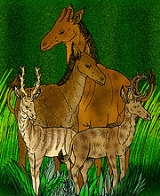
Palaeotragus
Encyclopedia
Palaeotragus was a genus of very large, primitive okapi
from the Miocene
of Africa
, Asia
, and Europe
.
Palaeotragus primaevus is the older species, being found in early to mid-Miocene
strata, while Palaeotragus germaini is found in Late Miocene strata.
P. primaevus is distinguished from P. germaini by having no pair of ossicone
s. It was also the smaller species, being a little under 2 metres at the shoulders. P. germaini had a pair of ossicones, and in life, it would have resembled either a short-necked, 3 metre tall giraffe, or a gargantuan okapi
.
Okapi
The okapi , Okapia johnstoni, is a giraffid artiodactyl mammal native to the Ituri Rainforest, located in the northeast of the Democratic Republic of the Congo, in Central Africa...
from the Miocene
Miocene
The Miocene is a geological epoch of the Neogene Period and extends from about . The Miocene was named by Sir Charles Lyell. Its name comes from the Greek words and and means "less recent" because it has 18% fewer modern sea invertebrates than the Pliocene. The Miocene follows the Oligocene...
of Africa
Africa
Africa is the world's second largest and second most populous continent, after Asia. At about 30.2 million km² including adjacent islands, it covers 6% of the Earth's total surface area and 20.4% of the total land area...
, Asia
Asia
Asia is the world's largest and most populous continent, located primarily in the eastern and northern hemispheres. It covers 8.7% of the Earth's total surface area and with approximately 3.879 billion people, it hosts 60% of the world's current human population...
, and Europe
Europe
Europe is, by convention, one of the world's seven continents. Comprising the westernmost peninsula of Eurasia, Europe is generally 'divided' from Asia to its east by the watershed divides of the Ural and Caucasus Mountains, the Ural River, the Caspian and Black Seas, and the waterways connecting...
.
Palaeotragus primaevus is the older species, being found in early to mid-Miocene
Miocene
The Miocene is a geological epoch of the Neogene Period and extends from about . The Miocene was named by Sir Charles Lyell. Its name comes from the Greek words and and means "less recent" because it has 18% fewer modern sea invertebrates than the Pliocene. The Miocene follows the Oligocene...
strata, while Palaeotragus germaini is found in Late Miocene strata.
P. primaevus is distinguished from P. germaini by having no pair of ossicone
Ossicone
Ossicones are horn-like protuberances on the heads of giraffes, male okapis, and their extinct relatives, such as Sivatherium, and the climacoceratids, such as Climacoceras. Only giraffids have true ossicones...
s. It was also the smaller species, being a little under 2 metres at the shoulders. P. germaini had a pair of ossicones, and in life, it would have resembled either a short-necked, 3 metre tall giraffe, or a gargantuan okapi
Okapi
The okapi , Okapia johnstoni, is a giraffid artiodactyl mammal native to the Ituri Rainforest, located in the northeast of the Democratic Republic of the Congo, in Central Africa...
.

